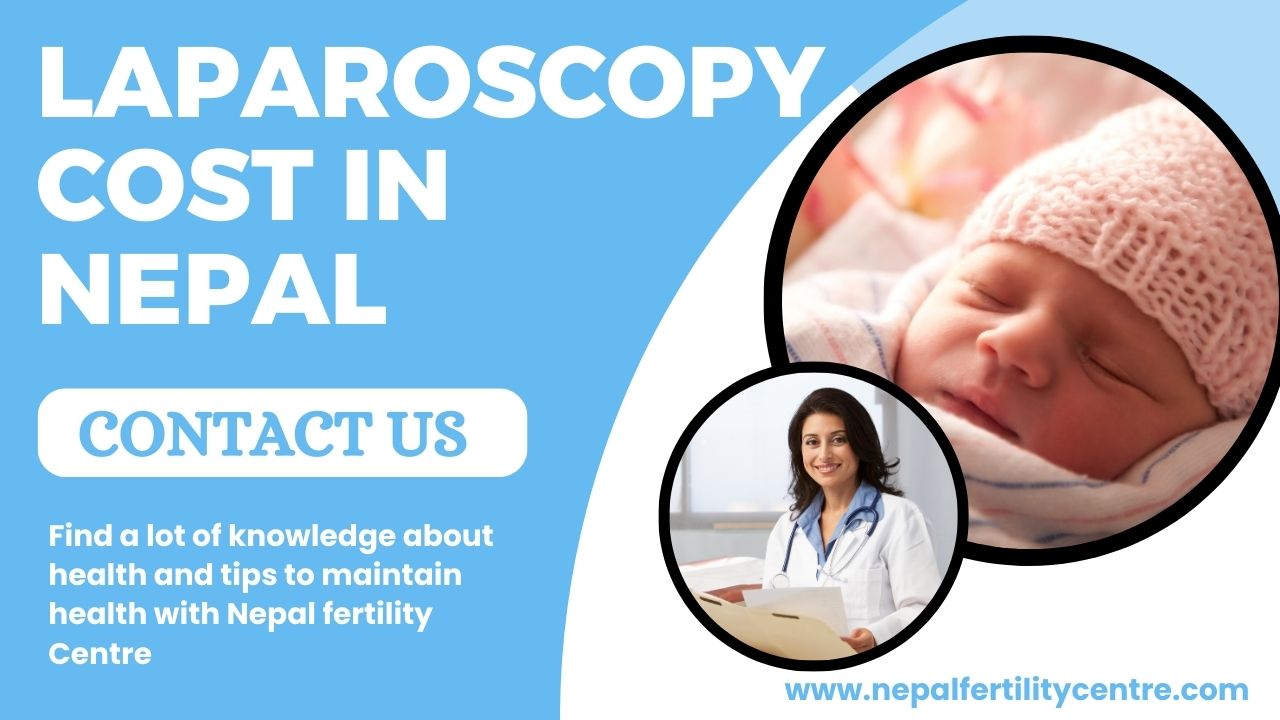Laparoscopy, a revolutionary advancement in the field of surgery, has transformed the way medical professionals diagnose and treat various conditions. This minimally invasive procedure, also known as keyhole surgery or minimally invasive surgery (MIS), involves the use of a laparoscope—a thin, flexible tube equipped with a light and camera—to examine the inside of the abdominal or pelvic cavities. This Laparoscopy Cost In Nepal technique has significantly impacted modern medicine, Nepal Fertility Centre offering numerous benefits over traditional open surgery.
Definition and Overview of Laparoscopy
Laparoscopy, derived from the Greek words “lapara” (flank or side) and “skopein” (to see), involves the insertion of the laparoscope through small incisions in the abdomen. This instrument allows surgeons to visualize the internal organs in real-time on a monitor, facilitating precise examination and intervention. Unlike open surgery, which requires large incisions, laparoscopy minimizes trauma to surrounding tissues, resulting in reduced pain, shorter recovery times, and smaller scars.
The laparoscopic approach is applicable to a wide range of medical procedures, including diagnostic investigations, organ biopsies, and various therapeutic interventions. Surgeons can manipulate specialized instruments through additional small incisions, performing intricate procedures with enhanced precision.
Importance of Laparoscopy in Modern Medicine
The significance of laparoscopy in modern medicine cannot be overstated. This technique has revolutionized surgical practices across multiple disciplines, offering benefits that extend beyond the operating room. One of the primary advantages lies in its minimally invasive nature, which leads to decreased postoperative pain and a quicker return to normal activities for patients.
Moreover, laparoscopy reduces the risk of complications associated with open surgery, such as infections and excessive blood loss. The use of smaller incisions minimizes scarring, enhancing the cosmetic outcome and addressing the aesthetic concerns of patients.
In gynecology, laparoscopy has become a standard approach for procedures like hysterectomy and ovarian cyst removal. In general surgery, it is employed for gallbladder removal, hernia repair, and colorectal surgeries. The technique has also found applications in urology for procedures like kidney and prostate surgeries.
The importance of laparoscopy isn’t restricted for its clinical potential benefits; it has additionally added to the headway of clinical preparation. Specialists currently approach sensible test systems and computer generated reality stages to level up their abilities in a controlled climate, eventually working on persistent results.
As we dive further into the world of laparoscopy, it becomes obvious that this creative methodology has reshaped the scene of present day medication, offering patients more secure, more effective, and less intrusive options in contrast to customary careful techniques.

Understanding Laparoscopy
Laparoscopy, also known as minimally invasive surgery or keyhole surgery, has witnessed significant adoption and growth in Nepal’s medical landscape. This advanced surgical technique involves the use of a laparoscope, a thin, lighted tube with a camera, which allows surgeons to view and operate on internal organs through small incisions. This section explores the evolution of laparoscopy in Nepal, shedding light on its increasing popularity and the common laparoscopic surgeries performed in the country.
Adoption and Growth of Laparoscopic Procedures
In recent years, laparoscopy has gained widespread acceptance in Nepal due to its numerous advantages over traditional open surgeries. The adoption of laparoscopic procedures has been fueled by advancements in technology, increased surgeon expertise, and a growing awareness among both medical professionals and the general public.
Nepal’s medical community has embraced laparoscopy for its minimally invasive nature, allowing for quicker recovery times, reduced postoperative pain, and shorter hospital stays. The shift towards laparoscopic techniques is also driven by the desire to minimize scarring, lower the risk of infections, and improve overall patient outcomes.
Nepal Fertility Centre provide of state-of-the-art medical facilities and a skilled cadre of laparoscopic surgeons has played a pivotal role in the growth of laparoscopy in Nepal. Leading hospitals and clinics across the country have invested in advanced equipment and training programs to ensure that laparoscopic procedures are conducted with precision and efficiency.
Common Laparoscopic Surgeries in Nepal
Laparoscopy in Nepal encompasses a wide range of surgical procedures across various medical specialties. The versatility of this technique allows for the exploration and treatment of different conditions with minimal invasiveness. Some of the common laparoscopic surgeries performed in Nepal include:
- Laparoscopic Cholecystectomy (Gallbladder Removal): This technique is generally led to treat gallbladder-related issues, including gallstones. It includes the evacuation of the gallbladder through little cuts, bringing about less torment and a quicker recuperation contrasted with customary open a medical procedure.
- Laparoscopic Appendectomy: Laparoscopic appendectomy is the careful evacuation of the reference section through little entry points. It is a typical methodology to treat a ruptured appendix, offering a faster recuperation and decreased risk of complications.
- Laparoscopic Hysterectomy: In gynecology, laparoscopic hysterectomy is performed for the expulsion of the uterus. This insignificantly intrusive methodology decreases postoperative uneasiness and abbreviates the emergency clinic stay.
- Laparoscopic Hernia Repair: Hernias, both inguinal and ventral, can be actually fixed utilizing laparoscopic procedures. This approach limits the size of entry points and speeds up the healing process.
- Laparoscopic Colorectal Surgery: Colorectal conditions, like diverticulitis or colorectal malignant growth, can be tended to through laparoscopic medical procedure. This approach is related with less torment and a quicker return to typical exercises.
- Laparoscopic Nephrectomy: For conditions requiring the evacuation of a kidney, laparoscopic nephrectomy offers a less obtrusive choice to open a medical procedure, bringing about diminished recuperation time.
The accessibility of these laparoscopic strategies mirrors the flexibility and viability of this careful methodology in tending to a wide range of medical conditions in Nepal. As innovation proceeds to progress and clinical experts refine their laparoscopic abilities, the extent of laparoscopy in the nation is supposed to grow, giving patients more secure and more effective treatment choices.

Advantages of Laparoscopy Cost In Nepal
Laparoscopy, also known as minimally invasive surgery, has revolutionized the field of surgery with its numerous benefits. Here are three key advantages:
1. Minimally Invasive Nature
Laparoscopy is characterized by its minimally invasive approach, which involves making small incisions through which specialized surgical instruments and a tiny camera (laparoscope) are inserted. This stands in stark contrast to traditional open surgery, which requires larger incisions. The smaller incisions in laparoscopy result in reduced trauma to the surrounding tissues, leading to less pain, minimal scarring, and quicker healing.
- Reduced Tissue Trauma: Laparoscopic procedures cause less damage to surrounding tissues, muscles, and organs compared to traditional surgery. This contributes to a lower risk of postoperative complications and a speedier recovery.
- Cosmetic Benefits: The smaller incisions result in smaller scars, contributing to improved cosmetic outcomes. This is particularly relevant for procedures performed in visible areas, enhancing patient satisfaction.
2. Faster Recovery and Reduced Hospital Stay
One of the most significant advantages of laparoscopy is the accelerated recovery time and reduced duration of hospitalization. Patients undergoing laparoscopic procedures often experience a quicker return to their daily activities compared to those who undergo traditional open surgery.
- Quicker Healing: The minimally invasive approach limits injury and speeds up the mending system. Patients regularly experience less agony and inconvenience, empowering them to continue ordinary exercises sooner.
- Shorter Hospital Stays: Laparoscopic methods frequently bring about more limited clinic stays. Numerous patients are released around the same time or inside a couple of days, adding to generally medical services cost decrease and expanded patient satisfaction.
3. Lower Risk of Infections
Laparoscopy diminishes the gamble of careful site contaminations, a typical worry in customary open medical procedures. The more modest entry points and diminished openness of internal organs to the outside climate add to a lower probability of postoperative infections.
- Reduced Wound Complications: The more modest entry points made in laparoscopic medical procedure are related with a lower hazard of wound confusions, like contaminations and hernias. This is especially gainful for patients with fundamental ailments that might incline them toward infections.
- Preservation of Immune Function: The negligibly obtrusive nature of laparoscopy brings about less interruption to the body’s resistant system. This is significant for patients, as a compromised invulnerable system can build the susceptibility to infections during the recuperation time frame.
In Addition, the minimally invasive nature of laparoscopy, coupled with faster recovery and a lower risk of infections, makes it a preferred choice for various surgical interventions. These advantages not only enhance patient outcomes but also contribute to the efficiency and cost-effectiveness of healthcare delivery.

Laparoscopy Cost Factors in Nepal
Laparoscopy, a minimally invasive surgical procedure, has become increasingly prevalent in Nepal, offering patients an efficient and less intrusive alternative to traditional open surgeries. However, the cost of laparoscopy in nepal can vary based on several key factors, each of which plays a crucial role in determining the overall expenses associated with the procedure.
Medical Facilities and Infrastructure
The quality and sophistication of medical facilities contribute significantly to the cost of laparoscopy in Nepal. Hospitals equipped with state-of-the-art technology, advanced laparoscopic instruments, and modern infrastructure may charge higher fees for their services. The availability of cutting-edge equipment ensures a smoother and more precise surgical experience, impacting overall costs.
Key Considerations:
- Hospital accreditation and certifications
- Technological infrastructure and equipment standards
- Maintenance of a sterile and conducive surgical environment
Surgeon Expertise and Experience
The skill and experience of the performing surgeon are critical factors influencing laparoscopy costs. Highly trained and experienced laparoscopic surgeons may command higher fees due to their expertise and proven track record of successful surgeries. Surgeons with specialized training in specific laparoscopic procedures may also have an impact on the overall cost.
Key Considerations:
- Surgeon qualifications and certifications
- Years of experience in performing laparoscopic surgeries
- Specialization in particular laparoscopic procedures
Type of Laparoscopic Procedure
The intricacy and nature of the laparoscopic procedure itself assume a huge part in cost assurance. Essential analytic laparoscopy might be more affordable contrasted with additional many-sided medical procedures, for example, laparoscopic hysterectomy or gastric detour. The hardware, time, and assets expected for various techniques add to varieties in generally speaking expenses.
Key Considerations:
- Complexity and duration of the laparoscopic procedure
- Specific organs or areas targeted during the surgery
- Requirement for additional specialized instruments or equipment
Inclusion of Additional Services
The consideration of subordinate administrations can affect the general expense of laparoscopy in Nepal. This might include pre-employable evaluations, post-usable consideration, medicine, and follow-up counsels. Also, a few offices offer far reaching bundles that incorporate convenience, feasts, and transportation, adding to the general comfort for patients.
Key Considerations:
- Pre-employable indicative tests and discussions
- Post-employable consideration and medications
- Exhaustive bundles that incorporate additional services
Understanding these laparoscopy cost factors in Nepal enables patients to settle on informed conclusions about their medical services. It is vital for people to examine these variables with medical care suppliers, guaranteeing transparency and clearness in regards to the financial parts of their laparoscopic methods.

Comparative Analysis: Laparoscopy Costs Worldwide
Laparoscopy has become a staple in modern surgical procedures, offering numerous benefits such as minimal invasiveness, quicker recovery times, and reduced hospital stays. One crucial aspect for individuals considering laparoscopic procedures is the cost involved. In this section, we will delve into a comparative analysis of laparoscopy costs in Nepal and various countries worldwide, shedding light on the factors influencing global cost disparities.
1. Nepal
- Affordable Options: Nepal provides cost-effective laparoscopic procedures, attracting individuals seeking quality healthcare at a fraction of the cost in Western countries.
- Growing Reputation: The country’s medical infrastructure is gaining recognition for its affordability and competent healthcare professionals.
2. United States
- High Procedure Costs: The United States often ranks among the highest in terms of medical procedure costs, including laparoscopy.
- Insurance Dependency: Many individuals heavily rely on insurance coverage due to the substantial out-of-pocket expenses.
3. India
- Cost-Effective Options: India has gained a reputation for providing cost-effective medical services, including laparoscopy.
- Quality Facilities: Renowned hospitals in India offer state-of-the-art laparoscopic procedures at a fraction of the cost compared to Western countries.
4. European Countries
- Varied Costs: Laparoscopy costs vary across European nations, with Western European countries generally having higher expenses than Eastern European counterparts.
- Public vs. Private: Public healthcare systems may offer laparoscopy at lower costs compared to private facilities.
5. Southeast Asia
- Competitive Pricing: Countries like Thailand and Malaysia have developed competitive medical tourism industries, offering quality laparoscopic procedures at reasonable costs.
- Cultural Considerations: Understanding cultural aspects impacting medical costs is crucial for international patients.
6. South America
- Diverse Costs: Laparoscopy costs vary widely across South American countries, with factors such as economic stability and healthcare infrastructure influencing pricing.
- Argentina and Brazil: These countries may have higher costs due to their advanced healthcare facilities.
Factors Influencing Laparoscopy Costs Worldwide:
- Healthcare Infrastructure: Created countries with cutting edge clinical foundation frequently have greater expenses.
- Economic Factors: Economic stability assumes a critical part in deciding laparoscopy costs.
- Insurance Systems: The presence and construction of medical services protection influence the personal costs for people.
- Technological Advancements: Nations with the furthest down the line medical technology might charge higher expenses for laparoscopic methodology.
Understanding the similar scene of laparoscopy costs worldwide is fundamental for people looking for reasonable yet quality medical care. While Nepal stands apart as a financially savvy choice, patients should gauge factors like clinical mastery, offices, and extra expenses while settling on informed conclusions about going through laparoscopic systems both at home and abroad.

Transparency in Laparoscopy Pricing
In recent years, there has been a growing emphasis on transparency in healthcare pricing worldwide, and laparoscopic procedures are no exception. Patients seeking laparoscopy in Nepal, like anywhere else, benefit greatly from transparent pricing structures. This section explores the importance of transparent pricing, the availability of package deals, and additional costs that patients should consider.
Importance of Transparent Pricing
Transparency in pricing is crucial for fostering trust between healthcare providers and patients. When patients have a clear understanding of the costs associated with laparoscopic procedures, they can make informed decisions about their healthcare. Transparency also helps prevent surprise bills and ensures that patients are financially prepared for their medical journey.
Transparent pricing includes a breakdown of costs, encompassing surgeon fees, hospital charges, anesthesia costs, and any additional services or materials required during the laparoscopic procedure. By providing this information upfront, healthcare providers contribute to a more patient-centric and accountable healthcare system.
Availability of Package Deals
Some healthcare facilities in Nepal offer package deals for laparoscopic procedures, bundling various services together at a fixed price. These packages often cover pre-operative consultations, the surgical procedure itself, post-operative care, and follow-up appointments. Package deals can simplify the billing process and offer patients a comprehensive view of their financial commitment from the outset.
While package deals can provide cost savings and convenience, it’s essential for patients to scrutinize the details of what is included. Clear communication with healthcare providers ensures that patients are aware of any potential additional costs that may not be covered by the package.
Additional Costs to Consider
Beyond the primary components of laparoscopy pricing, patients should be aware of potential additional costs that may arise. These can include:
- Diagnostic Tests: Pre-operative tests such as blood work, imaging, and other diagnostic procedures may incur additional charges.
- Medication Costs: Professionally prescribed drugs expected previously, during, or after the system may not generally be remembered for the initial cost estimate.
- Post-operative Care: Costs related with follow-up appointments, non-intrusive treatment, or any surprising intricacies during recuperation.
- Incidentals: Random costs, for example, medical clinic outfit expenses, extra evenings in the clinic, or unique hardware required during recuperation.
Being all around informed about potential extra expenses permits patients to spending plan all the more successfully and forestalls monetary shocks during the laparoscopic venture. Medical care suppliers are urged to impart transparently about these likely expenses to guarantee patients have a far reaching comprehension understanding of their financial obligations.

Government Regulations and Support
In Nepal, the government plays a pivotal role in regulating healthcare costs, including those associated with laparoscopic procedures. Stringent regulations are in place to ensure that medical services remain accessible and affordable to the general population.
To make laparoscopy more affordable, the government has implemented various initiatives. These include:
- Subsidies and Funding: The government allocates funds to subsidize healthcare services, aiming to reduce the financial burden on patients seeking laparoscopic procedures. This ensures that essential medical treatments remain within reach for a broader segment of the population.
- Price Control Mechanisms: Regulatory bodies set price controls on medical services, including laparoscopic procedures. This prevents exorbitant pricing by healthcare providers, promoting fairness and affordability for patients.
- Public-Private Partnerships: The government engages in partnerships with private healthcare entities to enhance the availability of laparoscopic services. This collaboration fosters a balance between public and private healthcare, expanding the reach of affordable laparoscopy.
- Training and Education Initiatives: To improve the abilities of healthcare professionals and decrease the general expense of laparoscopic methods, the public authority puts resources into preparing programs. This guarantees a pool of qualified professionals fit for offering quality types of assistance at a sensible expense.
- Health Insurance Schemes: The government encourages the reception of health care coverage plots that cover laparoscopic methods. This offers monetary help to patients as well as elevates a proactive way to deal with medical services, underlining counteraction and convenient intercession.
In synopsis, the public authority’s proactive job in managing medical care costs and carrying out reasonableness drives mirrors a pledge to the prosperity of its residents. By establishing a strong climate for both medical services suppliers and patients, the public authority expects to make laparoscopy and other fundamental clinical benefits open to all, adding to the general wellbeing and government assistance of the country.
Insurance Coverage for Laparoscopy in Nepal
Insurance Coverage for Laparoscopy in Nepal varies. Policies often include laparoscopic procedures, but details differ among providers. Patients should carefully review policies, understanding inclusions, exclusions, and potential additional costs. Government initiatives aim to enhance coverage accessibility, and some facilities offer financial assistance. When opting for laparoscopy, it’s crucial to clarify insurance specifics, ensuring a comprehensive understanding of the financial aspects involved.
Choosing the Right Healthcare Facility
In the pursuit of optimal healthcare, selecting the right facility for laparoscopic procedures is a crucial step. This section will guide you through the process of researching hospitals and clinics, seeking recommendations, and understanding the significance of reviews.
Researching Hospitals and Clinics
- Accreditation and Certification: Start by checking the accreditation and certification of potential healthcare facilities. Recognized certifications ensure that the hospital meets specific quality and safety standards, offering a level of assurance to patients.
- Specialization in Laparoscopic Procedures: Look for hospitals and clinics that specialize in laparoscopic surgeries. Facilities with dedicated departments or teams for minimally invasive procedures often have experienced surgeons and advanced equipment, ensuring a higher quality of care.
- Infrastructure and Technology: Assess the foundation and innovative abilities of the healthcare facility. State-of-the-art equipment and present day framework add to the achievement and effectiveness of laparoscopic techniques.
- Surgeon Profiles and Expertise: Research the profiles of specialists partnered with the emergency clinic. Search for experienced laparoscopic specialists with a history of effective systems. Their expertise can significantly influence the result of your medical procedure.
- Patient Success Stories: Seek out patient success stories of overcoming adversity connected with laparoscopic systems at the office. Genuine encounters can give important experiences into the patient excursion, the nature of care, and the general fulfillment of people who went through comparable strategies.

Conclusion
The Laparoscopy Cost In Nepal is crucial for individuals considering or undergoing minimally invasive procedures. The country’s medical landscape, characterized by advancements in technology and skilled professionals, offers a range of laparoscopic surgeries with varying costs.
Transparency in pricing, government regulations, and insurance coverage play pivotal roles in shaping the financial aspect of laparoscopy in Nepal. Patient support programs and financial aid contribute to making these procedures more accessible.
By navigating these factors and considering personal experiences shared by others, individuals can make informed decisions about their healthcare. As laparoscopic technology continues to evolve, the future holds promise for enhanced affordability and further innovations in Nepal’s healthcare system.
IMPORTANT NOTICE: “SURROGACY IS NOT LEGAL IN NEPAL”
Frequently Asked Questions (FAQs)
Q1: What factors influence the cost of laparoscopy in Nepal?
A1: The cost is influenced by medical facilities, surgeon expertise, the type of procedure, and additional services provided.
Q2: Are laparoscopy costs in Nepal transparent?
A2: Yes, transparency is crucial, and many healthcare facilities provide clear breakdowns of laparoscopy costs.
Q3: Does the government regulate laparoscopy costs in Nepal?
A3: The government plays a role in regulating healthcare costs, contributing to fair pricing.
Q4: Is insurance coverage available for laparoscopy in Nepal?
A4: Yes, insurance policies often cover laparoscopic procedures, but coverage details may vary.
Q5: Are there financial assistance programs for laparoscopy in Nepal?
A5: Yes, various programs and nonprofits offer financial aid to make laparoscopy more accessible.
Q6: How can patients choose the right healthcare facility for laparoscopy in Nepal?
A6: Researching hospitals, seeking recommendations, and reading reviews can help patients make informed decisions.
Read Also:

